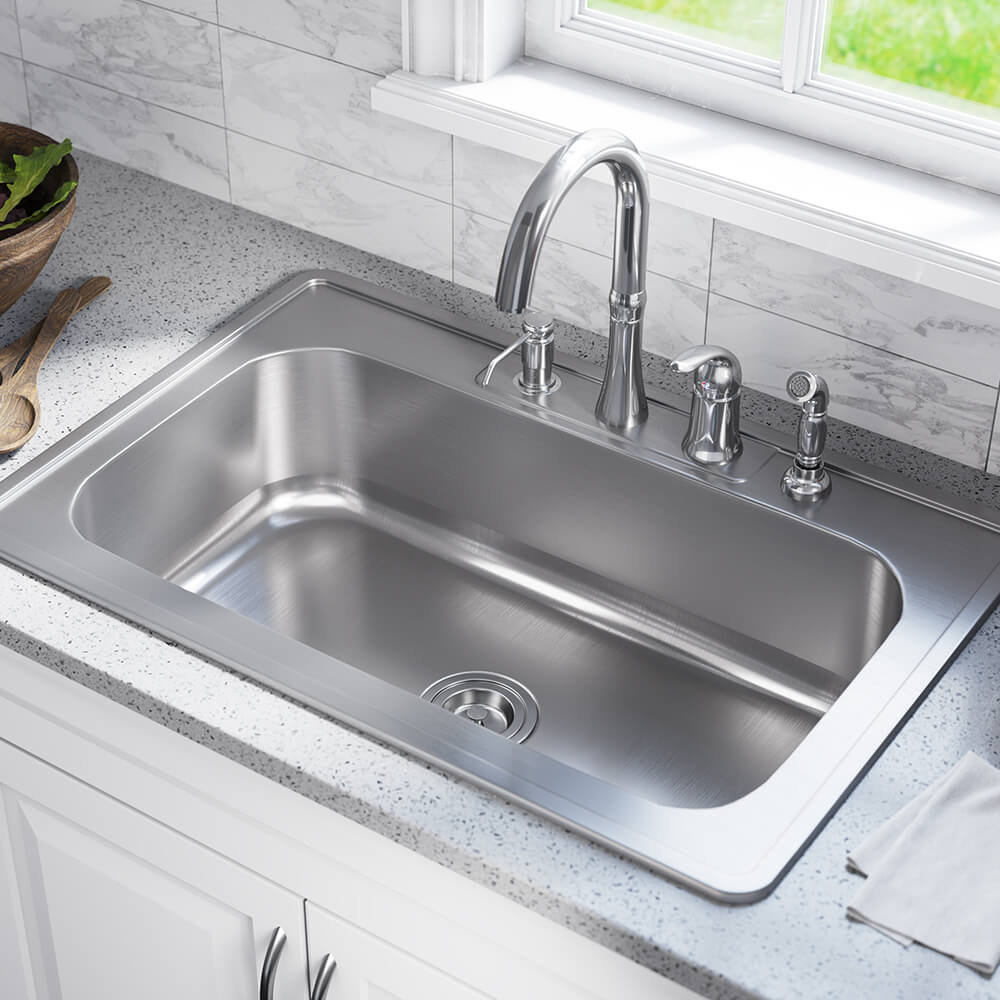Kitchen faucets seem like an easy substitute for bathroom faucets because they both serve the same purpose of providing water for cleaning. However, can kitchen faucets be used as a substitute for the bathroom?
A kitchen faucet can be used in the bathroom. Holes for the water hose must fit the proper width, and the sink bowl must handle the amount of water output for a kitchen faucet.
Kitchen sinks and bathroom vanities, however, are designed completely differently from one another. This article will explain why you shouldn’t use a kitchen faucet on the bathroom vanity.
Can You Use A Kitchen Faucet In The Bathroom?
The short answer is yes, but there are a few things that you should take precautions about before making a purchasing decision. The holes for the water hoses fit the bathroom faucet.
Most of the time, the plumbing differs from the kitchen to the bathroom. We recommend consulting with a plumber before making the call to use a kitchen faucet. This is because bathroom and kitchen faucets serve different purposes. The amount of water flow and output from kitchen faucets differ from those of a standard bathroom faucet.
The bowl must handle the drainage from the water output of the kitchen faucet hose. Bathroom faucets are often smaller and have smaller bowls to drain. This must be taken into consideration to avoid future plumbing issues.
The holes for bathroom vanities are often prefabricated to allow a standard structure for plumbers. It’s typically a 4-inch hole that is pre-drilled for easy plug and plays set up.
However, the sinkholes are often drilled in different ways with kitchen faucets to allow single hose nozzles or multiple handles. This is the biggest issue with using kitchen faucets in the bathroom.
Cons Of Using a Kitchen Faucet For a Bathroom Sink
We recommend you avoid using a kitchen faucet for the bathroom for a few reasons.
First, it will look entirely out of place. Kitchen faucets are typically hose-type faucets that disconnect from the holster to reach hard-to-clean places.
Bathroom vanities will look awkward and out of place with a large head that protrudes over the sink’s bowl.
On top of the nozzle/hose, the handles are often spaced wider for kitchen faucets. This could look awkward, clunky, and especially noticeable for guests who hobby interior decorating.
Our last reason is there isn’t a need to. There are so many beautiful options for both nozzle and handle faucets that it’s almost entirely unnecessary to use a kitchen faucet as a sink option.
If you’re stuck finding examples, here are two fantastic options for bathroom sinks that will hopefully change your mind.

Our first pick a the PARLOS swivel spout two-handle faucet. It’s a brushed nickel design and is great for homeowners looking for a two-handle system to distribute water to dirty hands.
The clean model and design are fit for almost any bathroom style. The 3-hole mount with a 4-inch center set fits any bathroom vanity for easy installation.
If you’re looking for more of a single faucet drain, our second pick is the Delta single-handle bathroom faucet.

Designed to fit three holes in 4-inch configurations, this bathroom faucet is another clean option for any vanity.
Delta WaterSense faucets use 20% less water than the industry standard sinks, which helps in the long run for water consumption.
Best Bathroom Faucets
All faucets do not fit every type of sink. Each type of faucet and sink is built for water use and absorption. We will cover two sinks, all directly related to the water output.
Also, these types of sinks are custom to the environment they will be in. Bathroom basins are often found within a cutout in a bathroom vanity.
Kitchen sinks typically have their cut-out, which is custom to the kitchen style.
We will show you two types of sinks and why all faucets may not be the best match for all sinks.
Bathroom Basin

A basin is a small bowl that can hold a small amount of water.
This type of bowl is typically used for washing hands or faces. It not only drains at a slower rate, it typically has less water pouring out of the spout to go along with the slow absorption.
Basin’s are often found in small household bathrooms and can handle simple tasks such as brushing teeth, washing face, or a quick rinse.
Kitchen Sinks

Kitchen sinks typically have bigger bowls that hold stacked dishes and dirty silverware. There’s a bigger surface for kitchen sinks because of the dispersed water.
When washing dishes, it’s common to have the sink running on maximum output.
The maximum output will flood a small bathroom basin, which is it may not make sense to have a large kitchen faucet in a bathroom sink.
If you’re going to use a kitchen faucet for the bathroom, we recommend making sure the water output matches the bowl catching the water. Too small of a bowl could result in flooding and water damage as it leaks.
Having a kitchen sink fit to match the water output of a bathroom basin may be tough. We recommend checking with your plumber to see if the hoses can be hooked up from the proper outpour of water.
It’s always better to be safe than sorry in this situation dealing with water from a faucet.
Conclusion
Kitchen faucets can be used as bathroom faucets, but only if they meet the three holes, 4-inch regulations. We highly recommend against using a kitchen faucet due to the overwhelming number of options available for bathroom sinks.
Shopping for bathroom faucets is a chore in itself. It’s much easier to purchase a bathroom sink and not have to worry about returning a kitchen faucet if it doesn’t meet requirements, is too big, or is too big for the drain.
Keep it easy on both yourself and your vanity, and search bathroom sinks! Let us know what bathroom sink is your favorite and, if you have found a kitchen faucet, why you would use it as your bathroom faucet.
We’ve compiled a complete list of frequently asked bathroom questions for new and experienced homeowners.
Our team of experts answers these questions to help assist you through DIY projects and home repairs.

For over a decade, Robin has been a real estate agent, interior design specialist, and mother. Through her trials and tribulations, she wanted to create the perfect website to help you save money and make your home look beautiful.
